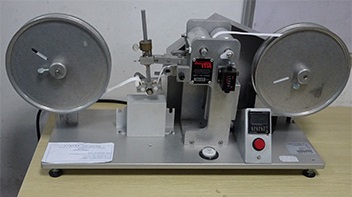How to Test Wear Resistance of Ceramic Materials?

Wear resistance in ceramics is one of the most studied properties, which has been explored in many different applications. Wear resistance generally refers to the material's ability to resist material loss by some mechanical action, such as abrasions and frictions. In this post, we’ll focus on the wear testing of ceramic materials, their importance, and common methods of ceramic wear testing.
What is Ceramic Wear Testing?
Note that ceramic materials can be wear-resistant and tough but not particularly hard, while a hard materials can be wear-resistant but not exactly tough. In other words, wear resistance is not synonymous with toughness or hardness in a material. The causes of wear can be categorized as adhesive wear, scraping wear, surface fatigue wear, and corrosion wear. The essence of ceramic wear test or wear testing, in general, is to determine the ability of the ceramic material to withstand abrasive wear under specified conditions. This data is then used to determine the kind of applications where the material will be used most effectively. During wear resistance tests, certain factors are typically considered. These are the material’s intrinsic surface properties, such as hardness, strength, ductility, and work hardening. Besides these, other essential factors to look out for include surface finish, lubrication, load, speed, corrosion, as well as temperature, and properties of the opposing surface.
Examples of Wear-Resistant Ceramics
Typical wear-resistant ceramics include zirconia, silicon nitride, boron carbide, cubic boron nitride, alumina, silicon carbide, etc. The determination of the wear resistance of ceramic materials is essentially vital to determining the best applications of these materials in mechanical devices. For instance, wear-resistant ceramics, such as the examples listed above, are widely used in grinding and polishing materials, structure parts, wear-resistant coatings, inner linings of pipes or equipment, etc. Note that the measure of wear-resistant of a ceramic material directly determines the safe service life of mechanical equipment and parts.
Methods of Wear Testing of Ceramic Materials
There are several methods used for the wear testing of ceramic materials. Here are some of them discussed in detail:
Taber Abrasion
Taber abrasion is a test used to determine a material’s resistance to abrasion. Taber abrasion tests have also been used for plastic materials. The abrasion resistance indicates how much it is resistant to wear, and ultimately, how the material is to be applied in productions. Resistance to abrasion is defined as the ability of a material to withstand mechanical actions like scraping, brushing, rubbing, or erosion. Abrasive wear is often difficult to compare. However, haze variation or weight loss are often evaluated.

Micro-abrasion Technique
Microabrasion techniques make it possible to easily study the surface wear of materials with greater precision than allowed by other methods. Microabrasion techniques allow the wear phenomenon of the top-most layers of the material to be studied while also ensuring that the wear resistance of the material being studied is not influenced by the substrate. In a study where a micro-abrasion technique (cratering with steel ball) was used to determine the wear resistance of traditional ceramic materials, it was shown that the method used is ideal for studying the wear performance of ceramic glazes. In order to adapt the test to the materials used, the individual effect of each test condition on wear resistance was isolated while keeping the other conditions constant. The variables studied are the:
- diameter and angular velocity of the ball
- abrasive suspension feed rate and grain size
- sample–ball contact angle and groove in the supporting drive shaft.
Finally, the values established were validated by the performance of the test on materials of a glassy nature.
Pin-on-Disk Wear testing
This is commonly used in tribological characterization techniques for estimating the coefficient of friction and the wear mechanism of Diamond films. Pin-on-disk testing can be used for characterizing the wear between two materials. This is a wear testing technique that has been used to evaluate the performance of a wear couple and for characterizing the performance of different materials against a standard surface.
RCA Wear Testing
The RCA Abrasion Wear Test is another ceramic wear test used for testing surfaces to determine resistance to abrasion and wear. This test is commonly used on painted or plated organic finishes, foil, etc. It is also widely used as a standard for many silicone keypads and membrane switches. RCA wear testing is also standard for the auto, appliance, cell phone, plastics, and coating industries.

Blade-on-Block Wear Testing
In blade-on-block abrasion testing, an object, otherwise known as the block, which articulates back and forth on a stationary specimen (also known as the blade) is used. The blade remains stationary while being subjected to a constant normal load. The lifespan of coatings and coefficient of friction are some examples of properties that this test can characterize.
Conclusion
Thank you for reading our article and we hope it can help you to have a better understanding of several ceramic wear testing methods. For more information, please visit https://www.preciseceramic.com/.
{{item.content}}
LEVE A REPLY
{{item.children[0].content}}
{{item.content}}
LEAVE A REPLY
SUBSCRIBE OUR NEWSLETTER
- AlN Ceramic Substrates: Enabling Next-Gen Electrostatic Chucks
- The Amor of Semiconductor Tools: Why High-Purity Al2O3 & AlN Are Preferred for Plasma Process Chambers
- Silicon Carbide - Ultra-High Temperature Ceramics for Extreme Environments
- Aluminum Oxide Ceramics: Properties and Applications
- Boron Nitride Coatings: The Solution for Molten Metal Applications










